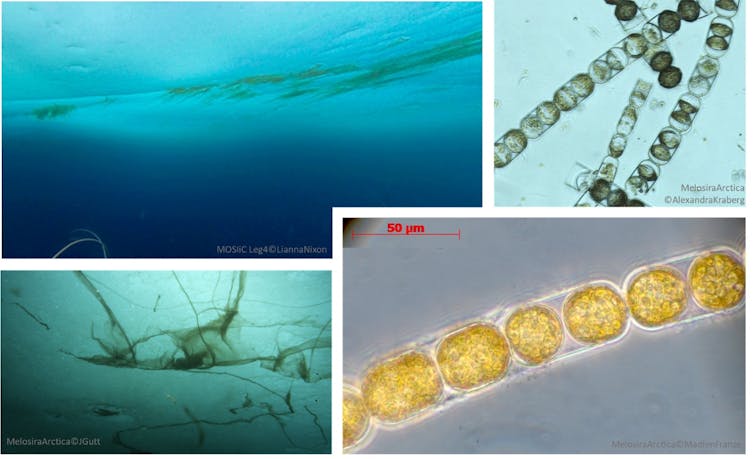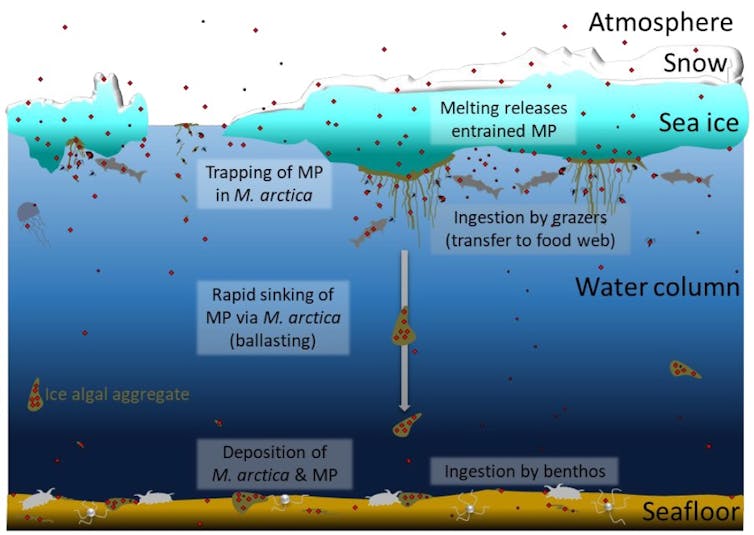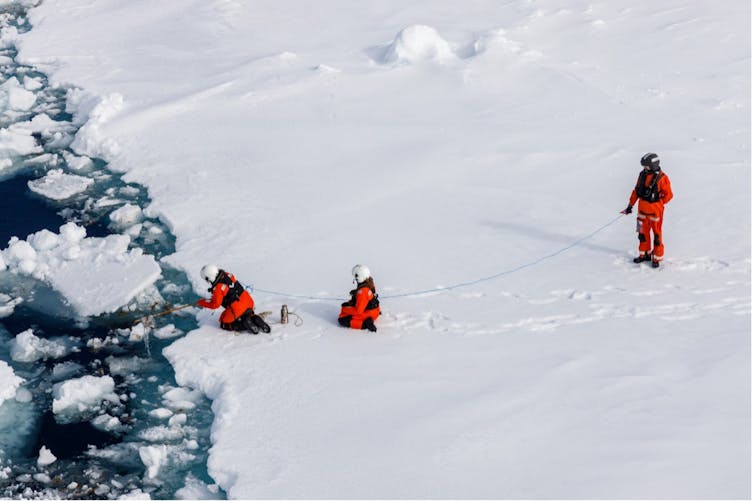Last summer, we travelled to the remote Arctic Hausgarten observatory area in the eastern Fram Strait (west of Svalbard, Norway) on a research ship. The samples we collected there included ice cores, sea water and ice algae from large packs of floating ice called ice floes. These form 1–2 metre thick “plates” of sea ice across the Arctic Ocean, some of which melt over the summer period.
Algae grow on the underside of these ice floes. Melosira arctica – nicknamed “snot” due to its sticky, slimy and green nature – is one of the major algae species in the Arctic Ocean. It is an essential organism both in the Arctic food web and for marine life overall.
These ice algae provide nutrition for plankton and various other marine organisms in the Arctic. The algae also act as a conveyor belt of food for the organisms that live on the sea floor. As the ice melts, the algae detach and sink to the bottom where they are eaten by animals such as sea cucumbers and brittlestars.
Ice algae are also a carbon sink, using CO₂ from the atmosphere and light energy from the sun to produce organic matter through photosynthesis – a process known in ecology as “primary production”. In 2012, these algae accounted for 45% of the Arctic’s primary production.
But now we’ve found that Arctic ice algae contain microplastics. This in itself may not be surprising: plastic has been found in every environment so far investigated on Earth. But the quantities we found were startling.
We discovered an average of 31,000 microplastic particles per cubic metre of Melosira arctica – a magnitude ten times higher than recorded in the surrounding water. Most of these particles were very small (less than 10 micrometres) and included many different types of plastic. The contamination of the ice algae could have major consequences for ecosystems and the climate.

An elevator to the seabed
These particles may come from the surrounding sea water, the supporting sea ice (either trapped when the sea ice forms, or from the movement of liquid and particles through the ice as it melts), or from atmospheric microplastics that have been deposited on the ice and sea surface. While the process by which sea ice algae take in these microplastics is not yet well understood, it is clear they are highly effective at “collecting” these small plastic particles.
In our earlier research, we were puzzled that the largest amount of microplastic on the Arctic seabed was always found underneath the sea ice melting zone along the ice edge, even in deep-sea sediment. The movement of Melosira clumps from the sea and ice surface to the seabed helps to explain why.
The speed at which the algal clumps descend means they fall rapidly almost in a straight line below the edge of the ice. Other algae, which become “marine snow” (a term used for organic material that slowly drifts to the seafloor), fall much slower. These are often eaten as they descend and are also pushed sideways by currents, so sink to the seabed much further away from the ice edge.

Why is it a problem?
Melosira feeds essential Arctic seafloor and marine ecosystems. Its position at the bottom of the food chain means there is a risk of microplastics being passed upwards through the marine food web.
This threat is particularly acute in the area we studied, as the Melosira sampled had collected even very small microplastics. Smaller microplastic particles are more likely to be transferred across cell membranes.

Research finds that microplastics and their associated chemicals can alter the growth, function and breeding of marine species such as plankton and fish. It is extremely difficult to perform experiments on Arctic or deep-sea species because of the challenges associated with replicating their environmental conditions. However, one laboratory study found that microplastic exposure caused egg production rates to increase by up to eight times in Arctic zooplankton – a response that is probably the result of stress.
The impact of microplastic contamination on Melosira itself is not yet known. But it’s possible that microplastics change Melosira’s abundance, lifespan and health.
Microplastics that are stuck to the outside of algae could lower photosynthetic rates by blocking out sunlight. And if particles enter the algal cells, then they could damage the parts of the cell where photosynthesis takes place (called chloroplasts) and therefore also impede this process. This could affect the export of carbon by Melosira from the air or sea to the seabed, and thus alter the processes underlying this important Arctic carbon sink.
Arctic ice algae are collecting high quantities of microplastics – a previously unknown hotspot. But our findings are likely just the “tip of the iceberg”. They should accelerate conversations about the importance, and potential impact, of microplastics in Arctic sea ice algae on the ecosystems that these vital algae support.
Deonie Allen received funding from Leverhulme Trust through grant ECF-2019-306 and the European Union’s Horizon 2020 research and innovation program under the Marie Skłodowska-Curie grant agreement no. 101023635.
Melanie Bergmann receives funding from German Government via the Alfred Wegener Institute Helmholtz Centre for Polar and Marine Research.
steve allen receives funding from the Canadian government through Ocean frontiers Institute.
This article was originally published on The Conversation. Read the original article.







